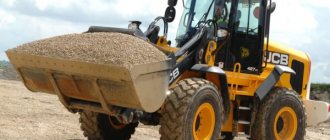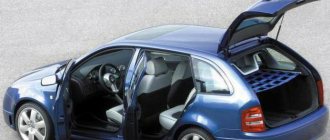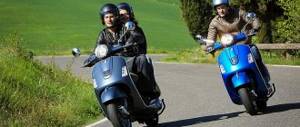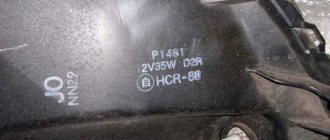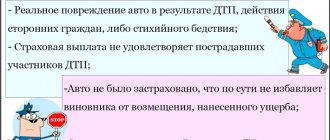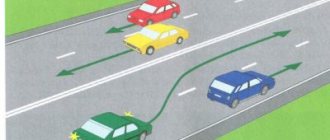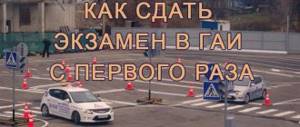Loaders, like excavators and dump trucks, are among the most popular among special equipment. The machines can be used on a construction site, in a production workshop, warehouse, or logistics center. Today, having a permit to drive a forklift, you can find a sought-after, high-paying job. Modern models are equipped with convenient levers and pedals, which greatly simplifies the control of front-end loaders and forklifts, both with manual (manual) and automatic (automatic) transmissions.
Types of forklift control levers
The mechanisms responsible for the movement, control and stopping of equipment are conventionally divided into the following groups:
Travel levers
A loader with a manual transmission and an automatic transmission with mechanical gear selection is equipped with two shift knobs - one for selecting the direction of travel, the second for selecting a gear. Using these controls, you can move forward/backward and change speed - two to four gears for moving forward and one to two for moving backward.
If you set the driving direction switch lever to the “R” position, the equipment will begin to move backwards, a special signal will sound, the headlights will light up, or the reverse signal will turn on.
To start moving and change the direction of movement of a self-propelled material handling machine, the brake pedal must be pressed before switching the lever. To switch the direction back and forth and vice versa, the machine must be completely stopped.
Gear shift lever
Before starting to operate the gear shift lever (for a fully automatic transmission), the brake pedal is depressed. After the pressure on the brake pedal is released, the car begins to move slowly. In this case, the speed shift knob is in any position except neutral. The brake pedal is fully released only after you are completely ready to move.
The equipment is equipped with one shift lever located on the steering column. There are two to four gears for forward movement and one to two for reverse movement. In the “R” position, the reverse lights come on or the horn sounds. Switching the direction of movement of the vehicle from front to rear and vice versa is carried out only after the vehicle has completely stopped.
Manual control of the loader
Manual control of a loader with an automatic transmission with a mechanical gear selection involves working with a direction shift lever corresponding to the steering wheel drive switch (for a fully automatic transmission). Before starting the equipment, the lever must be set to the neutral position. Otherwise, the special equipment will not start.
Steering column tilt lever
Before starting the loader engine, the operator must sit in the driver's seat and adjust the steering column lever to position "A". This will allow the steering column to be secured. It is not safe to make adjustments while the equipment is moving. You should choose the most convenient angle of the steering column so that the driver can work comfortably. To do this, the lever is moved to position “B”, the optimal angle of inclination is selected, the handle returns to mode “A” and the selected position is fixed.
Parking brake
To park the forklift, the wheels must be blocked. To block the 2 rear (usually) wheels, the lever is pulled towards itself. To release the parking brake, the release button at the top of the lever is pressed and held, and then the lever is moved forward.
Carriage lift lever
Before operating the forklift, it is important to ensure that no one is nearby. To raise the forks, pull the carriage lift lever towards you. To lower the forks, the handle must be moved to the forward position. The lifting speed of the attachment is adjusted by changing the tilt of the lever, engine speed, and pressing the accelerator pedal. You can speed up or slow down the lowering of the forks only by changing the angle of the lever. The number of revolutions of the loader engine does not affect the speed of lowering the forks.
Tilt lever
Before working with equipment, it is important to make sure that there are no people nearby. To tilt the mast back, the tilt lever is moved back. To change the direction of the mast and move it forward, the handle is set to the forward position. You can change the speed of movement of the mast using the tilt lever and the gas pedal.
When the engine is not running, it will not be possible to tilt the mast forward, because the tilt lock on the control valve is activated. If you press the lift lever while the forklift engine is not running, the forks will lower forward.
Inching pedal
The inching pedal for an automatic transmission is designed for use during high-speed operation. Lightly pressing the pedal reduces the hydraulic clutch pressure. When the pedal is pressed all the way, the clutch is completely disengaged and the braking system is activated. It is not allowed to turn on “slow travel” to slow down the equipment when going down or going up a slope, because the clutch will be disconnected, which will make engine braking impossible. Refer to your forklift owner's manual for more information on how to operate the crawl pedal.
Brake
To slow down the movement of special equipment, press the brake pedal. When pressed, the brake lights come on.
Accelerator
You can speed up the movement of the forklift by pressing the gas pedal. When you release pressure on the accelerator pedal, the forklift engine starts to idle. On gasoline models, a manual or automatic choke is used to start the loader in cold weather.
OCCUPATIONAL SAFETY REQUIREMENTS BEFORE STARTING WORK
2.1. Before starting work, forklift drivers must:
— check the serviceability of personal protective equipment, if work conditions require their use;
— inspect the roads and passages along which the cargo will be transported; if some sections of the route are slippery (doused with water, machine oil, etc.), it is necessary to take measures to eliminate contamination. In winter, roads must be cleared of snow, and in case of ice, sprinkled with sand or slag.
2.2. Check the serviceability of the forklift; make sure that there is no damage to the chains and that they are properly attached to the frame and carriage of the forklift, check by external inspection the welds of the upper brackets, chains, the reliability of the fastening of the pins, the hinges of the levers, as well as the operation of all mechanisms of the forklift.
2.3. Check the condition of the tires and their pressure.
2.4. Inspect the engine; check whether fuel is leaking from the tank, pump and taps, check the presence and level of brake fluid in the master cylinder, and whether the flexible hoses are damaged.
2.5. Check the operation of the foot and hand brakes and adjust them if necessary.
2.6. Check the amount of play and proper operation of the power steering, the connection of the steering arms and rods, as well as the ball pins of the power steering.
2.7. Make sure that the sound signal, brake light and turn lights, headlight switches, and rear lights are working properly.
2.8. Check the operation of the lifting and tilting mechanisms of the forklift frame.
Joystick control technique
The joystick is located in the loader cab to the right of the driver.
Forklifts are controlled using a joystick as follows:
- for lifting - point the handle towards you;
- to lower - push the joystick away from you;
- loading movement of the bucket (raking) - handle to the left;
- releasing the bucket from the load - moving the handle to the right.
The joystick control system is extremely easy to learn. In some modern models, the control unit includes a mobile joystick. This is convenient for the operator who will perform the work with his left hand - the handle is installed on the left side. This greatly simplifies the operation of mini-loaders, and operators save effort - just put your hand on the joystick, while keeping your shoulders and arms practically relaxed.
To ensure safe operation of the equipment, before starting the engine, you need to make sure that the machine is in good working order, check its technical readiness for work - the level of coolants, oil, brake fluid, fuel level, charging the electric forklift battery. Be sure to check the operation of the brake and clutch pedals, parking brake, gear shift lever, serviceability of the turn-on elements, sound and light signals.
Why do you need a forklift license?
The “forklift” profession is considered one of the most promising and in demand in the modern world. The construction sector is constantly expanding, trade turnover is growing, and the volume of private cargo transportation is increasing. The means of transport used for loading have become more compact, easier to control and more convenient. But a regular driver's license is not enough to operate this equipment. To become a forklift driver, you need a special license. It regulates work on forklifts and electric forklifts, which are actively used in various warehouses, enterprises and terminals.
Thus, the answer to the question of whether you need a license for a forklift is clearly affirmative.
Attachments
In most cases, the main attachment of a loader is a bucket. It is used for loading bulk cargo, moving, and storing. However, if necessary, special equipment can be supplemented with a fork part. The forks allow you to conveniently work with tared and palletized loads. Most forks are designed to move loads in an up/down direction. However, there are also models with a telescopic boom that can extend several meters forward. But even in such multifunctional options, ease of control of the loader is ensured. To operate equipment, you must have a state-issued “forklift operator” certificate with the required categories.
Return to news list
OCCUPATIONAL SAFETY REQUIREMENTS DURING WORK
3.1. Before starting to move, lifting or lowering a load, as well as in all cases when there is a danger of injury or collision with workers, the forklift driver is required to sound a warning sound.
3.2. When meeting workers along the route, the forklift driver must warn them with a signal, being at a distance of at least 5 m; If workers do not move out of the way, stop the loader.
3.3. It is not allowed to simultaneously carry out loading and unloading operations, manual carrying and transportation of goods in the forklift operating area. When in the work area
3.4 During operation, the forklift driver must:
- be attentive and not be distracted from performing your duties;
— while driving, avoid sudden braking and turning, unless they are caused by the situation on the road or safety reasons;
- sound a sound signal in crowded places, in aisles, when passing doors and through gates, when turning, starting off and reversing;
— when the engine is running, the loader is in the cabin;
— when approaching the loading (unloading) place, reduce speed;
— approach the vehicle for loading and unloading operations only after it has stopped and the engine has been turned off;
- lift the load smoothly, without jerking, by moving the lever slowly;
— lift (lower) the load while the loader is stopped;
— take special care when moving the loader along narrow passages (passages);
— loading of bulk material should be carried out along the entire front of the stack or face, without going deep into the stack along one track;
— clean the bucket from adhering soil or material in the lowered position with a shovel or scraper;
- do not allow approaching the edge of the cliff;
— do not allow the bucket to come into contact with the dump truck body or the canal slope. When moving soil over the edge of a cliff or when the machine reaches the top of a slope, the load is suddenly reduced and there is a danger of a sudden increase in speed. In this case, it is necessary to reduce the speed;
— when the bucket is not fully loaded, never suddenly start, turn or stop the machine;
— when unloading into a dump truck, make sure that there are no people in the work area and reduce the impact force during unloading.
3.5. When moving the loader, the working equipment must be secured in the transport position.
3.6. Before lifting and lowering a load, it is necessary to first inspect the place from which the load will be lifted and where it will be placed, and also make sure that there are no people under the load.
3.7. If the forklift becomes unstable (when the rear wheels begin to lift off the ground), the forklift driver must immediately lower the load.
3.8. It is not allowed to lift and transport cargo with an unspecified weight, a weight exceeding the lifting capacity of the loader, or to use additional counterweights.
3.9. A load frozen to the ground or covered with snow must first be cleared of snow and then lifted.
3.10. The movement of loads that obstruct the view of the road must be carried out with the participation of a person accompanying the forklift, giving the necessary signals to the forklift driver and warning other workers about the danger.
3.11. The forklift driver is prohibited from:
— lower the load onto open gas and steam pipelines, electrical cables, temporary ceilings;
— load and unload cargo from the vehicle while there are people in the cab or back of the vehicle;
— fill the loader bucket by cutting into a stack of bulk and small-sized materials from acceleration. Frozen cargo is loosened to restore flowability and ensure unloading;
- touch uninsulated, damaged wires and electrical distribution devices, run over electrical wires lying on the ground.
3.12. In winter it is prohibited:
— warm up (warm up) the engine, other components of the loader, as well as fuel system equipment with an open flame;
— work on a loader with a faulty cabin heating device;
— touch metal objects, parts and tools without using personal protective equipment;
— perform work lying under the loader without using an insulated mat.
3.13. When working to clear snow, you must pay special attention to roadsides and other hazards hidden under the snow.
3.14. When operating a boom loader, the load must be lifted first and then moved.
3.15. Lifting and moving loads with a loader with a crane boom in places dangerous for work must be done only upon signals from the slinger or in the presence of the work manager.
3.16. To prevent the crane boom loader from tipping over, it is not allowed to lift a load that is outside the boom.
3.17. It is not allowed to extend the boom to increase its reach. The driver of a forklift with a crane boom is responsible for maintaining the seal on the fork securing the length of the boom.
3.18. It is necessary to lift a load or container by grasping all the mounting loops or rings provided by the design.
If the cargo mounting loops or container rings are faulty, then the cargo or container must be lifted with slings using corner spacers between the slings and the edges of the cargo or container.
3.19. When loading, unloading and moving cargo, the driver of a forklift with a crane boom is obliged to control the measures taken by the slingers to prevent swaying and torsion of the cargo.
3.20. No people are allowed under the boom while the loader is operating with a crane boom.
3.21. The driver is required to carry out loading and unloading operations in the security zone of an existing overhead power line under the direct supervision of an engineer and technical worker responsible for the safe performance of work, with written permission from the organization that owns the power line and has received a permit that determines safe working conditions.
How to learn to drive a forklift
During the training, the employee will learn to drive a loading machine, operate hydraulic loading forks and load and unload goods. The practical part of the training involves fully preparing the worker for independent work, therefore an exam is also held at the end of the classes.
Training and full preparation for independent work with a forklift is the only guarantee of an employee’s ability to cope with any tasks assigned to him, however, it should be remembered that, as in any other business, the main thing in operating a forklift is practice and experience. That is why, after the exam, workers first undergo training in warehouses with their more experienced colleagues, and only after that are allowed to work completely independently.
To the list of articles
Slow motion
It is prohibited to control the crawl speed by simultaneously pressing the accelerator pedal and brake pedal. Low speed driving is accomplished by pressing the clutch pedal or trolling pedal halfway. NOTE
• Driving in this mode for an extended period of time may cause damage to the forklift • Do not rest your foot on the clutch pedal or trolling pedal while driving. You may accidentally press the clutch halfway, causing damage to the forklift.
Forklift - controls and features
Regardless of the specifics of warehouse work , their implementation will one way or another require the use of complex high-tech equipment. One of the most common types of equipment that can be found in almost any large warehouse is forklifts. The main task of forklifts is to transport and lift loads that cannot be moved manually. Any employees who will subsequently work in warehouses must undergo mandatory training and education in the rules of operating forklifts.
Despite the apparent complexity of forklifts, obtaining a license to operate one takes much less time than to operate any other cargo equipment. Workers who first get a job in warehouses are sent to specialized training departments, where they learn all the intricacies of operating forklifts.
Like the rights to operate any other equipment, obtaining the rights to operate forklifts can be divided into two parts - studying the theoretical part and practical management experience. Unlike the same driver's license, the theory of forklift control is given on average in three to four days, but after training the employee is required to pass an exam, based on the results of which a decision is made on whether the employee is allowed to practice.
During practical classes, students will learn not only the very basics of operating loading equipment, but will also independently perform simple work and tasks in conditions as close as possible to working conditions in warehouses.
Loading work
The methods used to control a front loader when performing loading operations differ. The most effective work is considered to be when minimizing the angle of rotation of the loader with a minimum distance between it and the dump truck.
There are two methods. The first is to move the forklift in reverse. The dump truck is positioned between the loader and the material. This is a fast and efficient loading method. Requires a level construction site.
The second method involves the following sequence:
- Parking at a 60 degree angle to the loading machine. With the bucket filled, the loader moves towards the dump truck in reverse and unloads;
- the soil must be unloaded into the middle of the dump truck. If its length exceeds 2 widths of the bucket, loading begins from the front;
- soil is unloaded into the dump truck by moving the control lever to the right position;
- the remaining material stuck to the bucket is shaken off by moving the control lever to the right and left;
- Before unloading, the bucket must be shaken so that the material is evenly distributed in it. This will prevent sticking.
How to lift a forklift on a freight elevator
Do not drive a forklift into a freight elevator unless it is designed to lift vehicles. In other cases, you must first ensure that the total weight of the forklift and cargo does not exceed the lifting capacity of the elevator. You should enter the elevator car carefully: first, stop the loader at a safe distance from the elevator doors, then slowly drive it in at a right angle. In the elevator car, set the forklift controls to neutral, turn off the engine and apply the brake.
